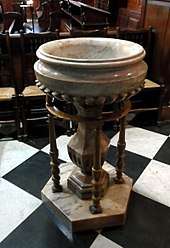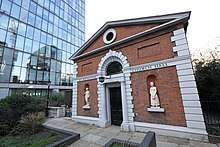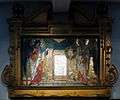St Botolph-without-Bishopsgate
| St. Botolph-without-Bishopsgate | |
|---|---|
|
Exterior photo of St. Botolph-without-Bishopsgate | |
| Country | United Kingdom |
| Denomination | Church of England and Antiochian Orthodox Church |
| Previous denomination | Roman Catholicism |
| Architecture | |
| Heritage designation | Grade II* |
| Administration | |
| Diocese | London |
| Clergy | |
| Rector | Alan McCormack |
St Botolph-without-Bishopsgate is a Church of England church in the City of London, and also, by virtue of lying outside the City's (now demolished) eastern walls, part of London's East End.
Adjoining the buildings is a substantial churchyard – running along the back of Wormwood Street, the former course of London Wall – and a former school.[1] The church is linked with the Worshipful Company of Coopers and the Worshipful Company of Bowyers.
Position and dedication
The church lies on the west side of the road named Bishopsgate, near Liverpool Street station. The church and street both take their name from the "Bishop's Gate" in London's defensive wall which stood approximately 50 metres to the south.
Stow, writing in 1598 describes the church of his time as standing "in a fair churchyard, adjoining to the town ditch, upon the very bank thereof".[2] The City Ditch was a defensive feature, that lay immediately outside the walls and was intended to make attack on the walls by mining or by escalade more difficult.
The church was one of four in medieval London dedicated to Saint Botolph or Botwulf, a 7th-century East Anglian saint, each of which stood by one of the gates to the City. The other three were near neighbour St Botolph's Aldgate, St Botolph's, Aldersgate in the west and St Botolph's, Billingsgate by the riverside (this church was destroyed by the Great Fire and not rebuilt).[3]
Before the legend of Saint Christopher became popular, Botolph was venerated as the patron saint of travellers, which is thought to be why churches at the City gates have this dedication.[4]
History
The first known written record of the church is from 1212 .,[5] however it is thought that Christian worship on this site may have Roman origins, though this is not fully proven.[6]
The church survived the Great Fire of London in 1666, and was rebuilt in 1724–29.
Middle ages
In around 1307, the Knights Templar were examined here by an inquisition on charges of corruption,[5] and in 1413 a female hermit was recorded as living here, supported by a pension of forty shillings a year paid by the Sheriff.[5]
It narrowly escaped the Great Fire, the sexton's house having been partly demolished to stop the spread of the flames.[7] Writing in 1708, Hatton described it as "an old church built of brick and stone, and rendered over". By this time the Gothic church had been altered with the addition of Tuscan columns supporting the roof, and Ionic ones the galleries.[2]
Present church

In 1710, the parishioners petitioned parliament for permission to rebuild the church on another site, but nothing was done. In 1723 the church was found to be irreparable [7] and the parishioners petitioned again. Having obtained an act of Parliament, they set up a temporary building in the churchyard, and began to rebuild the church. The first stone was laid in 1725, and the new building was consecrated in 1728, though not completed until the next year. The designer was James Gold.[8] or Gould.[9] During construction, the foundations of the original Anglo-Saxon church were discovered.
To provide a striking frontage towards Bishopsgate, the architect placed the tower at the east end, its ground floor, with a pediment on the exterior, forming the chancel. The east end and tower are faced with stone, while the rest of the church is brick, with stone dressings.[8]
The interior is divided into nave and aisles by Composite columns, the nave being barrel vaulted. The church was soon found to be too dark, so a large west window was created, but this was largely obscured by the organ[8] installed in front of it in 1764.[7] In 1820 a lantern was added to the centre of the roof.[8]
The church was designated a Grade II* listed building on 4 January 1950.[10]
The church suffered minor bomb damage in the second world war and subsequently in the 1993 Bishopsgate bombing.
By permission of the Rector, The Orthodox Parish of Saint Botolph in London[11] worships there, part of the Antiochian Orthodox Archdiocese of the British Isles and Ireland.[12]
Baptisms, marriages and burials
The infant son of the playwright Ben Jonson is buried in the churchyard, and baptisms in this church include Edward Alleyn in 1566, Emilia Lanier (née Bassano; widely considered to be the first Englishwoman to become a professional poet) on 27 January 1569, and John Keats (in the present font) in 1795.[13] Emilia Lanier married Alfonso Lanier in the church on 18 October 1592.[14] Mary Wollstonecraft, author of A Vindication of the Rights of Woman, was baptised there in 1759.[15]
At one point the satirist and essayist Stephen Gosson was rector. The didactic poet Robert Carliell (fl. 1619), who championed the new Church of England, held property in the parish.[16]
Church hall

Within the churchyard, the church hall is the Grade II, former Hall of the Worshipful Company of Fan Makers. It is a single storied classical red brick and Portland stone building, with niches containing figures of charity children.[17]
The figures which stood in the niches at the front of the building were previously painted every year by schoolchildren, but have since been restored and stripped of paint and, due to theft attempts, moved inside the hall. Modern replicas now stand in the niches on the front of the building.[18]
Church surroundings
Also within the area of the church is a Turkish bath designed by the architect, Harold Elphick, and opened by City of London Alderman Treloar on 5 February 1895 for Henry and James Forder Nevill who owned other Turkish baths [19] in Victorian London.
Gallery


 St Botolph-without-Bishopsgate, Church hall
St Botolph-without-Bishopsgate, Church hall Turkish bath
Turkish bath
Notes
- ↑ Betjeman, John (1967). The City of London Churches. Andover: Pitkin. ISBN 0-85372-565-9.
(rpnt 1992)
- 1 2 Pearce, C.W. (1909). Notes on Old City Churches: their organs, organists and musical associations. London: Winthrop Rogers.
- ↑ Daniell, A.E. (1896). London City Churches. London: Constable. p. 317.
- ↑ Richardsn, John (2001) The Annals of London: A Year-by-year Record of a Thousand Years of History, W&N, ISBN 978-1841881355 (p. 16)
- 1 2 3 Hibbert, C; Weinreb, D; Keay, J (1983). The London Encyclopaedia. London: Pan Macmillan. ISBN 978-1-4050-4924-5.
(rev 1993, 2008)
- ↑ "History of the Building". Parish and Ward Church St Botolph-without-Bishopsgate. Retrieved 4 November 2016.
- 1 2 3 Malcolm, James Peller (1803). Londinium Redivivium, or, an Ancient History and Modern Description of London. 1. London. p. 334.
- 1 2 3 4 Godwin, George; John Britton (1839). "St Botolph's, Bishopsgate". The Churches of London: A History and Description of the Ecclesiastical Edifices of the Metropolis. London: C. Tilt. Retrieved 19 September 2011.
- ↑ Bradley, Simon; Pevsner, Nikolaus (1998). London:the City Churches. The Buildings of England. London: Penguin Books. p. 38. ISBN 0 14 071100 7.
- ↑ Historic England. "Details from image database (199309)". Images of England. Retrieved 24 January 2009.
- ↑ "St. Botolphs Antiochian Orthodox Church". www.antiochian-london.org. Retrieved 2017-04-14.
- ↑ "Homepage - Antiochian Orthodox Christian Archdiocese of the British Isles & Ireland". Antiochian Orthodox Christian Archdiocese of the British Isles & Ireland. Retrieved 2017-04-14.
- ↑ Tucker, T (2006). The Visitors Guide to the City of London Churches. London: Friends of the City Churches. ISBN 0-9553945-0-3.
- ↑ Page on Emilia Bassano by Peter Bassano, her "first cousin, twelve times removed" Retrieved 7 April 2016.
- ↑ Gordon, Lyndall (2006). Vindication : a life of Mary Wollstonecraft (1st Harper Perennial ed.). New York: Harper Perennial. p. 7. ISBN 0060957743.
- ↑ Sidney Lee, "Carleill , Robert (fl. 1619)", rev. Reavley Gair (Oxford, UK: OUP, 2004) Retrieved 27 May 2017. Pay-walled.
- ↑ Historic England. "Details from image database (199320)". Images of England. Retrieved 24 January 2009.
- ↑ At St Botolph's Hall - Spitalfields Life. Retrieved 6 October 2018.
- ↑ Turkish baths in Victorian London
External links
Coordinates: 51°31′0.15″N 0°4′53.96″W / 51.5167083°N 0.0816556°W